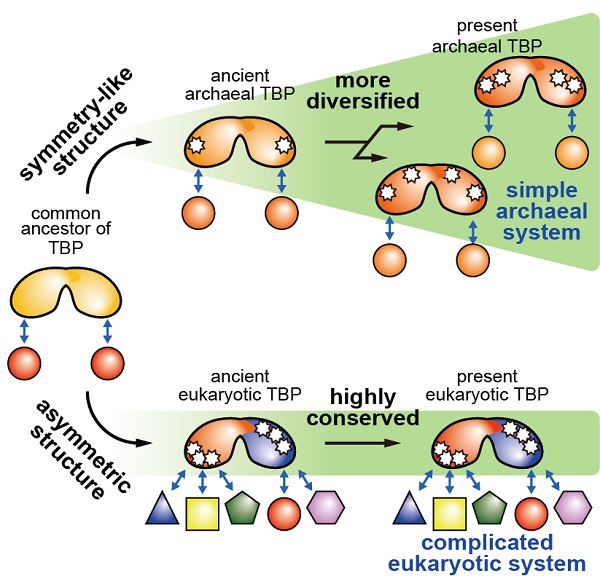Scientists reveal how eukaryotic transcription systems gained complexity New evolutionary indicator helps uncover ancient transcription systems


Mechanism giving rise to complexity of eukaryotic transcription initiation system
At present, nearly all studies on the mechanisms of biological phenomena focus on existing organisms. This study looks at the mechanism that gave rise to the complexity of eukaryotic transcription initiation systems when eukaryotic cells emerged from archaea about 2.5 billion years ago.
© 2018 Eiryo Kawakami, Naruhiko Adachi, Toshiya Senda and Masami Horikoshi.
Researchers at the University of Tokyo and their collaborators have revealed for the first time the mechanism by which the system that initiates transcription in eukaryotes gained complexity when organisms in this domain evolved from archaea about 2.5 billion years ago.
In studying evolution, scientists generally use fossils to estimate when organisms diverged from their common ancestors. In the field of molecular evolution, researchers look at identical or closely related sequences in DNA and proteins of existing organisms to trace their evolutionary history by applying such methods known as sequence comparison, measurement of evolutionary distance, and phylogenetic analysis. However, these methods have inherent drawbacks: Because genes of ancient organisms can no longer be found, we cannot measure the evolutionary distances, or changes in the genes, between existing organisms and their ancestors. Therefore, the evolutionary process of the whole gene family has never been determined.
In a previous study published in 2016, the research group led by Associate Professor Masami Horikoshi of the Institute for Quantitative Biosciences at the University of Tokyo developed a new analytical method for measuring the evolutionary distances between existing and ancestral organisms by focusing on sequences that repeat themselves within a gene. The group utilized these so-called direct repeat sequences (nucleotide sequences repeated in the same orientation or direction) as an evolutionary measure for assessing the degree of similarity between present offspring genes and their ancestors. With the newly defined evolutionary indicator designated as the distance between direct repeats, the researchers overcame the shortcomings of pre-existing methods and revealed the mechanism by which the system that initiates the copying of genetic information, known as transcription, became more complex as eukaryotic cells arose from the archaea domain of organisms about 2.5 billion years ago. Until now, the biological systems of ancient organisms could be pieced together only by analyzing the systems of existing organisms. The current study provides a clear answer, void of speculation, to a problem in molecular evolution unsolved up to now.
The quantitative measurement of molecular evolution developed by the group promises not only detailed insights into the evolution of biological systems underlying cell growth and proliferation at the system level, but information gained from such studies could also be applied to the "evolutionary process" of artificial intelligence and precision machinery.
"I have been tackling the problem of ancient transcription systems for the last 30 years," says Horikoshi. He continues, "The findings of the current study are the natural consequence of always challenging difficult problems and persevering with my research."
Paper
, "Leading role of TBP in the establishment of complexity in eukaryotic transcription initiation systems", Cell Reports Online Edition: 2017/12/27 (Japan time), doi: 10.1016/j.celrep.2017.12.034.
Article link (Publication)
Links
Institute for Quantitative Biosciences
Laboratory of Developmental Biology, Institute for Quantitative Biosciences (Japanese)






